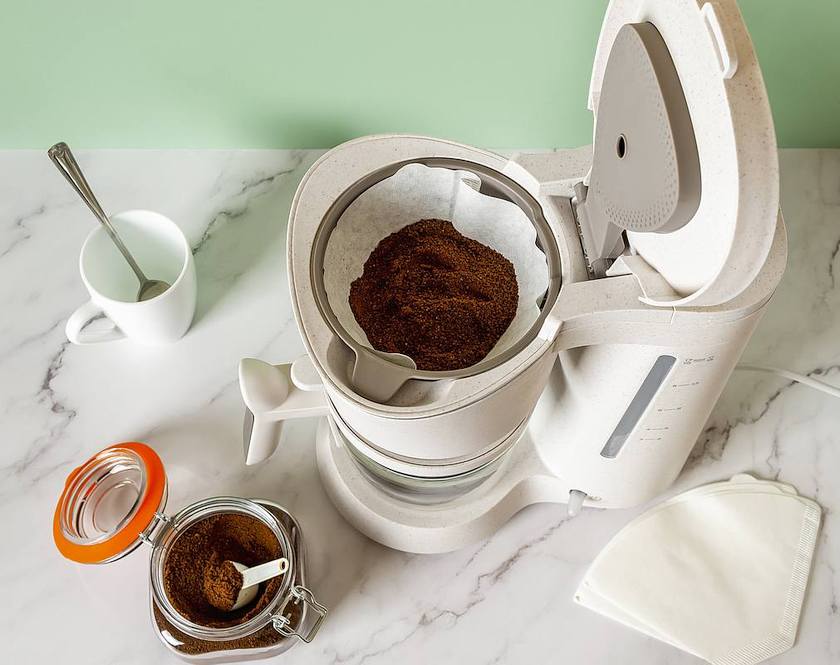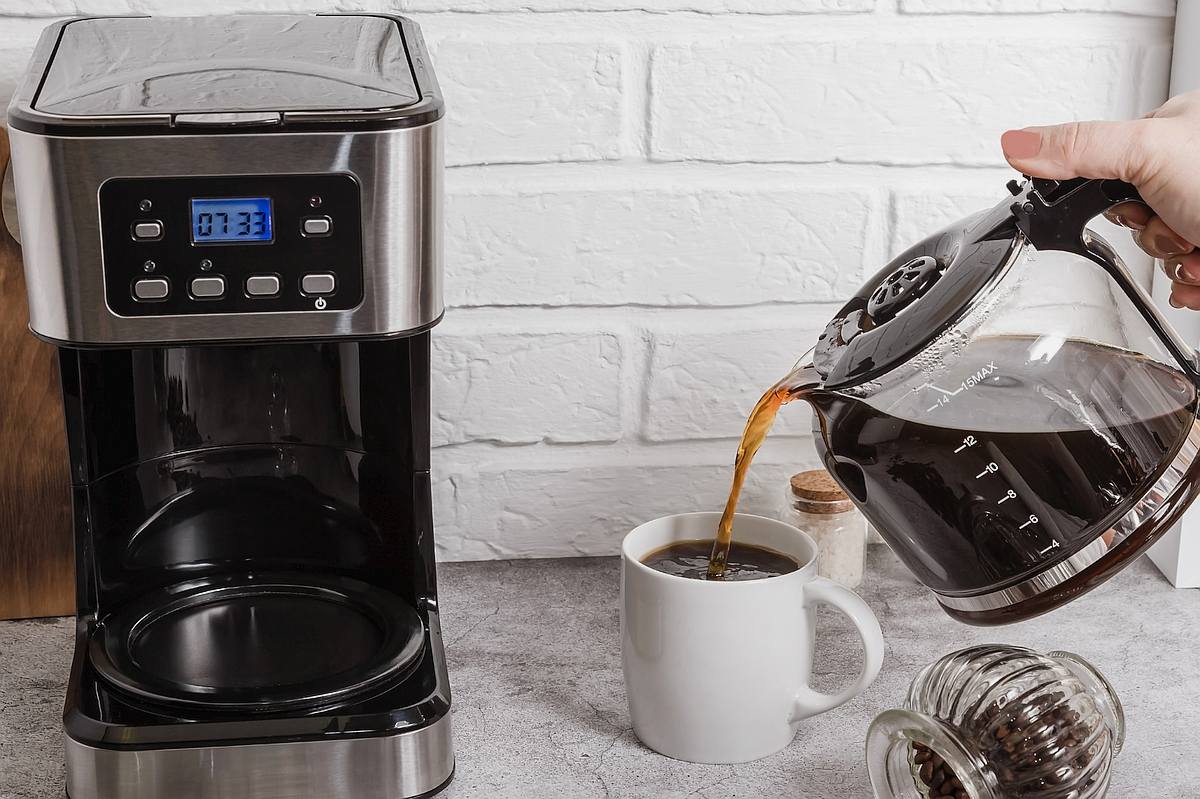Drip coffee is the perfect pick-me-up for those who want a quick caffeine fix without the hassle of fancy equipment. But what exactly is drip coffee and where did it come from?
Let’s spill the beans on this beloved beverage, from its origins to the rich flavors that will tantalize your taste buds.
Get ready to awaken your senses with every sip of this liquid gold. Drip coffee is the epitome of simplicity, yet its complex taste profile is sure to leave you feeling anything but basic. So grab your favorite mug and get ready to experience the magic of drip coffee.
What Is Drip Coffee?
Drip coffee is a coffee brewing method where water is poured over roasted ground coffee beans, held in a filter, allowing the water to drip slowly through the grounds and filter into a carafe or mug.
This coffee making type is also called filter coffee, or American coffee, or sometimes named brewed coffee. The term brewed coffee is a misnomer, since all types of coffees are brewed.
Drip coffee makers are typical household items manufactured in various sizes and designs, from small, commercial-grade units to huge, single-cup pour-over sets.
Many people prefer the simplicity and convenience of drip coffee over other brewing techniques, making it a popular and simple method of preparing coffee.
History of Drip Coffee – Where Did This Method Originate From?
Drip coffee has a long and illustrious history. The Turks developed the earliest documented drip brewing technique in the 15th century. They boiled water in a pot and then poured it over ground coffee contained in a cloth bag. This technique extended to other regions of the Middle East and Europe with a few adjustments.

The German entrepreneur named Melitta Bentz created the contemporary drip coffee maker in 1954 as she explored other coffee making methods to remove the grounds and sediments typically found in brewed coffee. She tested various materials before opting for a paper filter, which helped solve her problem. Her creation gained popularity fast, and by the 1970s, drip coffee makers were a typical household item.
With so many different pieces of equipment and methods accessible today, drip coffee is one of the most popular coffee preparation methods. We can find it at the office, in the coffee shop, in restaurants and diners.
How Does Drip Coffee Work?
The drip coffee brewing process involves pouring hot water over ground coffee beans contained in a filter. Then, with the help of gravity, water seeps through the coffee grounds, dripping into a carafe or mug below – giving a rich flavor and fragrance.
The brewing process heavily relies on the water temperature in the coffee maker staying between 195°F and 205°F (90°C to 96°C). Afterward, the hot water is poured over a filter (usually paper, cloth, or metal mesh) containing the coffee grinds, which removes much of the sediment or grounds, resulting in a smoother coffee.

For this method, the coffee grind size is crucial since it can impact how quickly water goes through the grounds and affects the final flavor of the coffee cup. The coffee beans are ground to a medium size, and in combination with the coffee bed size, and the filter, it will create a flow resistance in order to calibrate the total brew time. The total brew time is around 5 minutes. Depending on preferences, this can be tweaked up and down by about 1 minute.
Timing the brewing process is critical. If we brew too short, we do not extract enough soluble solids from the grounds. If we brew too long we might extract too much soluble material, and we will extract undesirable compounds, that affect negatively the taste of the beverage.
One of the benefits of the drip coffee brewing method is the convenience of producing a lot of coffee within minutes. Also, this procedure is efficient and straightforward, requiring very little equipment. Therefore, it’s cost-effective and convenient as it works with any type of coffee bean.
For a complete tutorial on how to make drip coffee, check our dedicated article.
Differences Versus other Methods
The most important difference versus French press and Espresso is the filtration method. Because espresso and French press don’t use paper filters, the final coffee cup we get contains more oils than filter coffee.
On one hand the oils impart coffee a stronger flavor, which is what some coffee lovers look for. On the other hand the coffee oils, and the coffee fines tend to overwhelm more delicate flavors that are prized by filter coffee drinkers.
Drip coffee is renown for its light body, with clean and bright flavors. Single origins will shine brewed this way, since diterpenes and very small coffee particles are effectively retained by the paper filter.
Caffeine levels are about the same as most other preparation methods. We are talking about the amount of caffeine extracted from the same amount of coffee grounds. The only exception is espresso, which paradoxically, extracts less caffeine from the same amount of grounds.
What Are the Different Types of Drip Coffee Makers?
There are three main types of drip coffee makers: automatic, manual, and single-serve, each with its own pros and cons.

- Automatic drip
An automatic drip coffee maker is one of the most common types available due to its ease of use and simplicity. These often feature an integrated water tank that can be programmed to brew automatically at a set time. With little manual effort, you can produce a large amount of coffee.
Automatic drip coffee makers don’t provide as much control over the brewing process as other methods. In addition, they may cost more to operate over time as paper coffee filters and regular maintenance are required.
The biggest issue with automatic drip coffee machines is the built quality. In order to ensure optimal extraction, the machine’s components need to be of high quality, and properly calibrated. There are very few machines on the market that ensure proper extraction.
- Manual drip
A manual drip coffee maker, such as pour-over setups, and manual drip brewers like the Hario V60 and Chemex require a more hands-on approach when brewing. They give you more control over the brewing process as you can adjust the water temperature, pour rate, and grind size. However, you’ll need a separate kettle to heat the water, and overall, this process takes longer than other methods.
Manual drip is also called pour-over. The pour over market is rich with various manual devices that cater to a niche audience. Kalita Wave, Chemex, Hario V60 brew different coffee, with a distinct flavor. These coffee drippers have different shapes, and use proprietary paper filters in order to obtain a specific flow rate, at a given grind size.
The key difference between manual drip and other drip methods is the high level of control over the brewing variables.
- Single Serve
A single-serve coffee maker, such as the Keurig uses pre-packaged coffee pods or capsules to prepare a single cup of coffee. These are also easy to use and convenient but may be less cost-effective over time and offer fewer customizable options.
The biggest issue with single serve coffee is that the recipe cannot be tweaked at all. Many coffee lovers complain about single serve being too weak, but there is nothing to be done about it, since the coffee dose and the water quantity are fixed.
What are The Right Coffee Beans For Drip Coffee?
The first factor to consider is the coffee bean quality, and using freshly roasted, premium beans are recommended.
Secondly, consider the roast level when choosing your coffee beans, which significantly impacts the flavor profile. For example, darker roasts might be bolder and more intense, whereas lighter roasts typically have a brighter, fruitier flavor.
As different regions and countries produce beans with specific flavors, the origin of the beans also influences the taste. For instance, Colombian beans are well-known for having a nutty and chocolatey coffee flavor, whereas Ethiopian beans often have a fruity and floral taste.
Single origin coffees are preferred in specialty coffee circles and high end coffee shops for their uniqueness. Blends can add complexity to your coffee, but generally, drip coffee aficionados tend to prefer single origin versus blends.
You should make your own judgement whether to use a single-origin or a blend of beans. Single-origin beans originate from one specific location and thus have more unique flavors. Blends with a combination of beans from multiple regions tend to create a more complex flavor, but sometimes this complexity can be confusing for your taste buds.
What Brewing Variable Should You Consider When Making Drip Coffee?
- Coffee Measurements
A key variable is the water-to-coffee ratio. The proper coffee to water ratio is slightly different for various drip coffee methods. As a starting point, we can use the standard ratio – 1:15. This means one part coffee to 15 parts water. However, this can be adjusted based on personal preference, and the brewing method. Accurate water measurements will ensure consistent strength and flavor of the coffee.
- Grind Size & Consistency
A finer coffee grind size often results in a stronger and more intense flavor, while a coarser grind produces a milder taste. You should also ensure the grind’s consistency is even to ensure a smooth extraction that fully brings out the taste. Here is an in-depth article about drip coffee grind size for those who want to learn more.
- Coffee Temperature
The optimal coffee brewing temperature for drip coffee is between 195-205°F (90-96°C); otherwise, you may compromise the coffee flavor. There is a larger discussion on what is the perfect temperature to brew coffee, and I recommend you the article, if you want to master coffee brewing.
- Brewing Time
Depending on the desired strength, the recommended brewing time for drip coffee is between 3 to 5 minutes. It’s essential to make sure that the water is poured over the coffee grinds uniformly and that the coffee is stirred while it is being brewed.
In Summary: Why Drip Coffee is a Popular Brewing Method
Following these coffee making tips, such as water temperature, brewing time, and water-to-coffee ratio, will allow you to enhance the coffee flavor quickly and easily. For a delicious flavor, choose high-quality and fresh coffee beans and consider the roast level, origin, and blend before purchasing.
The main drip coffee benefits, such as convenience and an abundance of easy-to-use drip coffee makers, have helped increase the popularity of coffee worldwide.
